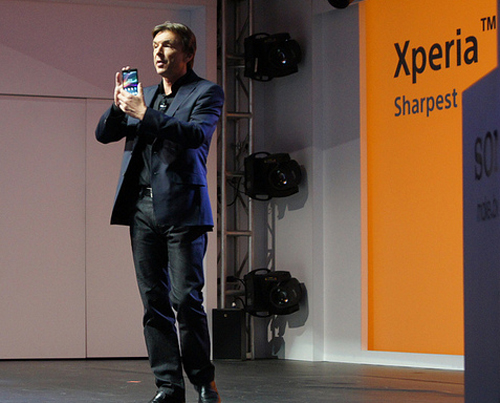The state of the smartphone art

Just out are the figures for last year's smartphone sales, and some 'finger in the wind' predictions of how the market will shape up this year – and with less than a month to go before the industry's annual bunfight in Barcelona, where most companies roll out new models, they make interesting reading.
Over 700m smartphones were shipped last year, with the numbers expected to rise to 850m this year. However, with developed markets maturing – smartphones now have 61% market penetration in the UK, and accounted for 82% of all phone sales in the 12 weeks up to Christmas – and new brands challenging in the developing sectors, competitition's set to get pretty tough.
Of course Sony got the jump on Mobile World Congress, which runs from February 23-28, by launching its Xperia Z at CES 2013, along with the smaller ZL model, three weeks ago.
The company's US boss, Phil Molyneux (above), demonstrated the phone, and its NFC music-playing capabilities during the company's main press conference at the international event.
Sony's got some catching-up to do in the global smartphone market, where it's currently expected to rank seventh in the world this year, according to market predictions from research firm Strategy Analytics. It suggests Sony will sell some 34m smartphones in 2013, taking 4% of the market.
Backing the Andoid horse
Mind you, Sony's backing the right horse in its choice of operating system, according to the same research company: 479m phones using the Android operating system were shipped worldwide last year, accounting for 68.4% of the record 700.1m smartphone numbers in 2012.
Get the What Hi-Fi? Newsletter
The latest hi-fi, home cinema and tech news, reviews, buying advice and deals, direct to your inbox.
By contrast, Apple iOS phones accounted for 19.4% of the total market, with some 136m units shipped.
That 700.1m units is up almost 43% on 2011's total, but there are signs that the smartphone market is slowing slightly, as mature markets reach maximum penetration levels – after all, 2011 saw a 64% growth on 2010's numbers.
Christmas/New Year sales
In the peak 'run up to Christmas/New Year' period – the fourth quarter of 2012, 152.1m Android phones were shipped, getting on for the quantities in Q4 2011, and giving the operating system a 70.1% share against 51.3% a year previously. Apple's iOS phones sold 47.8m units, up 20% year on year, but its share declined marginally to 22% against 23.6% in Q4 2011.
By brand, Samsung was clearly ahead of the rest, shipping 213m smartphones last year – more than double its 2011 total, to take a 30.4% market share. Apple came second, increasing sales 46% to 135.8m, and increasing market share a shade to 19.4%.
Next came Nokia, more than halving its 2011 sales to 35m last year, and losing almost 70% of its previous year's share to end up on 5%.
Samsung set to surge in 2013
So where do the market analysts see the main rivals sitting this year? Well, it's expected both of the main protagonists will sell more smartphones this year, with Apple rising 10% to hit 150m, while Samsung surges to 320m – a 50% increase on last year's figures – in a total smartphone market estimated to be 850m units.
That would give the Korean giant a 37.6% share of the market, and Apple 17%.
Behind those two, LG is expected to sell 48m smartphones, Huawei 42m, ZTE 37m, HTC and Sony Ericsson 34 million units apiece, BlackBerry manufacture RIM 3m and Nokia 2.6m.
And by 2016...?
The figures also give some historical context on Samsung's rise, and look even further forward: in 2010 it had 8% of the smartphone market, or about half of Apple's share. It overtook Apple in 2011, taking a 19.9% share, and it's predicted that by 2016 it could have as much as 39.5% of the global smartphone market, while Apple will remain stable on the 17% it's expected to hit this year.
Of course, all that could change depending on what the manufacturers have up their sleeves – and with the majority of phone users in the UK now using smartphones, they're going to have to go some to tempt many of us to upgrade.
We''ll be reporting on all the latest launches and developments at MWC in three weeks' time.
Andrew has written about audio and video products for the past 20+ years, and been a consumer journalist for more than 30 years, starting his career on camera magazines. Andrew has contributed to titles including What Hi-Fi?, Gramophone, Jazzwise and Hi-Fi Critic, Hi-Fi News & Record Review and Hi-Fi Choice. I’ve also written for a number of non-specialist and overseas magazines.
